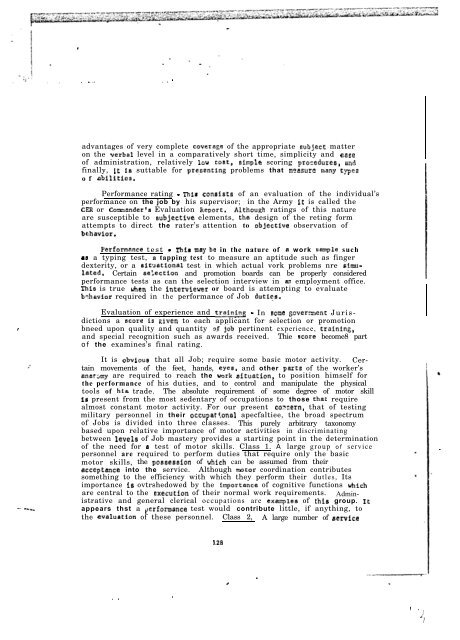Technical Report - International Military Testing Association
Technical Report - International Military Testing Association
Technical Report - International Military Testing Association
Create successful ePaper yourself
Turn your PDF publications into a flip-book with our unique Google optimized e-Paper software.
, *<br />
-. aa*<br />
Y<br />
. -..<br />
. . ’<br />
advantages of very complete coverege of the appropriate subSect matter<br />
on the verbnl level in a comparatively short time, simplicity and euee<br />
of administration, relatively IOU COBt, SimplC scoring proccdusee, und<br />
finally, it fs suttable for prqsenting problems that m?esure many cypvpco<br />
of abilities.<br />
Performance rating - This consista of an evaluation of the individual’s<br />
performance on the job by his supervisor; in the Army it is called the<br />
CEZR or Comandcr’s Evaluation hcport. Althcugh ratings of this nature<br />
are susceptible to subJective elements, the design of the reting form<br />
attempts to direct the rater’s attention to obJectfve observation of<br />
behavior,<br />
Pcrformnnce test - fifs mq be in the nature of a work umple such<br />
a8 a typing test, a tapping test to measure an aptitude such as finger<br />
dexterity, or a sitoational test in which actual vork problems nre aimsla&d.<br />
Certain ae?ection and promotion boards can be properly considered<br />
performance tests as can the selection interview in an employment office.<br />
This is true when the interviever or board is attempting to evaluate<br />
b?havlor required in the performance of Job dutiee.<br />
Evaluation of experience and trnu - In 8ome goverzticnt Jurisdictions<br />
a scnre is aiven to each applicant for selection or promotion<br />
bneed upon quality and quantity o.f jbb pertinent experience, iraining,<br />
and special recognition such as awards received. Thie wore become8 part<br />
of the examines’s final rating.<br />
It is obvioue that all Job; require some basic motor activity. Certain<br />
movements of the feet, hands, eyes, and other parte of the worker’s<br />
anntsmy are required to reach the L3.srk aituntlon, to position himself for<br />
the performance of his duties, and to control and manipulate the physical<br />
tools of his trade. The absolute requirement of some degree of motor skill<br />
is present from the most sedentary of occupations to those thrnt require<br />
almost constant motor activity. For our present co?zern, that of testing<br />
military personnel in their occupational apecfaltiee, the broad spectrum<br />
of Jobs is divided into three classes. This purely arbitrary taxonomy<br />
based upon relative importance of motor activities in discriminating<br />
between levels of Job mastery provides a starting point in the determination<br />
of the need for A test of motor skills. Class 1. A large group of service<br />
personnel are required to perform duties that require only the basic<br />
motor skills, the posoeseion of vhfch can be assumed from their<br />
cacceptunce into the service. Although M)tor coordination contributes<br />
something to the efficiency with which they perform their dutles, Its<br />
importance fs ovtrshedowed by the fmportance of cognitive functions which<br />
are central to the executfon of their normal work requirements. Administrative<br />
and general clerical occupations are exsnnplee of this group. It<br />
appears thst a pcrforoance test would contribute little, if anything, to<br />
the eveluetion of these personnel. Class 2, A large number of eervice<br />
. .<br />
.<br />
I.28<br />
,<br />
c<br />
! . *,!<br />
,)<br />
.









